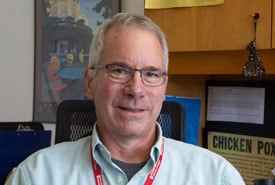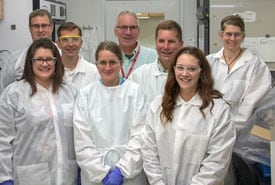Flu Fighter: Peter Shult
Meet influenza (flu) fighter Dr. Peter Shult, associate director of the Wisconsin State Laboratory of Hygiene and director of its Communicable Disease Division and Emergency Response. The state public health lab, located at the University of Wisconsin-Madison, is one of the country’s three National Influenza Reference Centers, or NIRCs, which serve as extensions of the Virus Surveillance and Diagnosis Branch in CDC’s Influenza Division and as critical components of the nation’s flu surveillance and pandemic readiness systems.
As a NIRC, the Wisconsin lab receives thousands of flu specimens each year from labs around the country for more advanced testing and monitoring. Laboratory staff characterize viruses circulating during each season, test viruses for antiviral resistance, and collect data to inform the next season’s flu vaccine composition. Their work — along with the work of NIRCs in California and New York — greatly expands CDC’s and the country’s ability to rapidly detect novel or pandemic flu viruses as well as signs of growing drug resistance.
For example, the Wisconsin lab characterizes flu surveillance specimens using next generation sequencing, a powerful technology that many public health labs aren’t yet equipped to do. The genetic data produced by next generation sequencing provides a clearer picture of how flu viruses are evolving, including acquiring resistance to antiviral drugs and timely detection of flu viruses with pandemic potential. That data, in turn, gives the CDC and fellow public health responders a critical advantage in staying ahead of this infectious disease threat that’s constantly changing.
For his part, Dr. Shult, who’s been at the Wisconsin lab since 1989, has always been interested in respiratory diseases, particularly flu viruses. And despite his nearly 30 years in the public health lab, he said flu viruses continue to surprise him.
“Just when you think you can predict what flu will do, it completely fools you,” Dr. Shult says, noting the particularly bad 2017-2018 flu season that took many by surprise. “As a public health practitioner, you have to go into every flu season expecting the worst, but it’s a challenge that we appreciate taking on.”
Name: Peter Shult, PhD
Title: Associate Director and Director of the Communicable Disease Division and Emergency Response, Wisconsin State Laboratory of Hygiene
Location: Madison, WI
- What role do you play in fighting flu?
My major function is overseeing the Communicable Disease Division at the Wisconsin State Laboratory of Hygiene, but it’s the people working in the lab who are the ones doing the work.My role is keeping myself and the staff informed on the public health threat that flu poses, keeping abreast of technologies that will improve our laboratory diagnostics, and advancing improvements in virologic surveillance at the state and national levels. I also spend a lot of time fostering relationships with clinical labs — they’re critical to our surveillance efforts not just for flu, but for a spectrum of public health threats — and facilitating partnerships that expand our funding and research opportunities and, ultimately, improve our capacities inside the lab. - What is the most rewarding part of your work?
The most rewarding part of my work is carrying out the public health duties we work and train so hard to do. When the A(H1N1) pandemic occurred in 2009, we were the lead testing lab holding down the fort until commercial testing kits became available and fellow public health labs were able to bring their A(H1N1)pdm09 testing abilities online. We helped lead national diagnostic efforts and we were able to do that, in part, because of a close relationship with CDC and with public health partners like the Association of Public Health Laboratories. Being chosen as a NIRC speaks volumes about the skills of our staff and about the capacity we’ve built. When the next pandemic occurs or a novel virus emerges — and it will — we’ll be on the front lines ready to respond and that’s very rewarding to know. - What is the most difficult part of your work?
Fighting the complacency that I know what’s going to happen. I would like to think that we’re always in a good position and we’re able to respond to anything, but the fact is that flu is so changeable and unpredictable. While it’s disconcerting to think that if there is an emergence of a novel virus, we could be behind the eight ball from the get-go, you can’t fall into the trap of believing that you know what’s going to happen next.
Of course, it would also be much easier if all we had to worry about was flu. The fact is our lab has to be ready to respond to all kinds of emerging threats, from the next SARS coronavirus to the next vaccine-preventable disease outbreak. Keeping up with all those developments and still giving just due to flu can be a challenge, though I think that’s a challenge that’s encountered by many, if not all, public health laboratories. There are so many other threats that we can’t always anticipate, and we have to be able to turn on a dime and address those without ignoring flu. - How serious is flu? What should people know about the risk of flu?
I’ve always recognized and strongly felt that flu is a very serious illness. In light of being 100 years out from the 1918 flu pandemic (which killed an estimated 675,000 Americans and at least 50 million worldwide), there are relatively few — if any other diseases — that have the potential to scale up to that kind of public health threat in such a condensed time frame.The possibility of another 1918 — even if it was significantly less severe than that pandemic — there just isn’t another threat like it. And beyond the morbidity and mortality associated with a pandemic, think of the social disruption it could cause, the impacts on families and the economy. There aren’t many threats with that kind of potential impact. - What would you say to those who are hesitant to get a flu vaccine?
Getting the flu is as sick as many people have gotten in their lifetimes. When I had the flu, that’s as miserable as I had ever felt for five or four days straight, period. Period. So get a flu vaccine; when your kids are sick, keep them home; if you get sick, take yourself out of circulation for a reasonable period of time. Do the things we were taught to do in kindergarten — cover your cough and wash your hands. Those are things we can control and they improve the chances that we won’t get sick and we won’t transmit flu or another respiratory disease to somebody else. Flu vaccines aren’t always as effective as we want them to be, but getting vaccinated still decreases your chances of getting the illness and can prevent the potentially serious outcomes that flu can bring. Any time you can lower your risk of getting a disease, that’s better than going unprotected.



